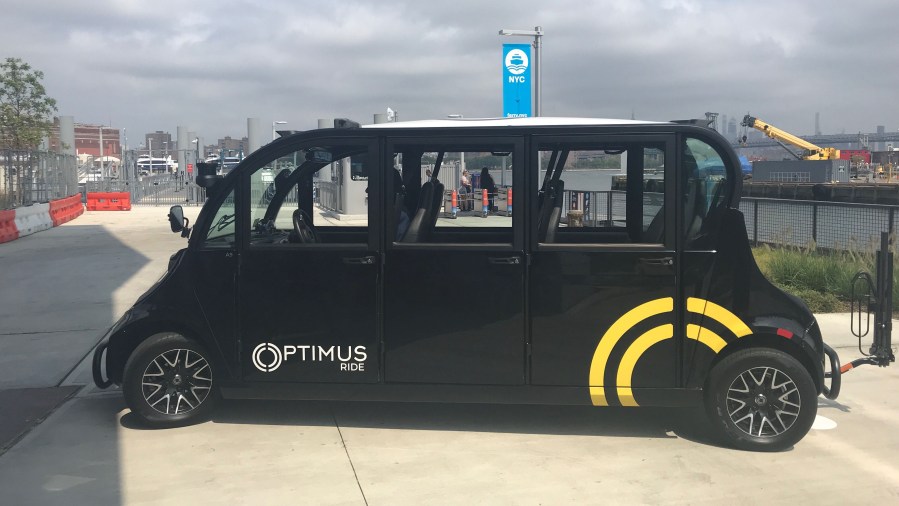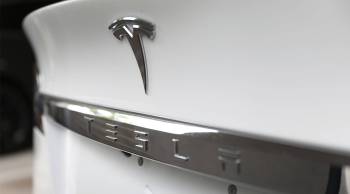Before driverless cars come driverless office park shuttles?

There’s no one way forward for autonomous vehicle technology. Waymo, Alphabet’s self-driving car company, is still testing fully autonomous cars as taxis in the Phoenix area. Tesla is putting semi-autonomous features into its cars for customers to buy. But some companies, like Boston-based startup Optimus Ride, are thinking the immediate future may be a little more contained.
The startup (yes, it’s named after the Transformer) is betting on low-speed vehicles that carry people around defined geographic areas. It’s not the most exciting use of autonomous driving tech, but it might be more doable, sooner.
Optimus Ride just started a contract giving people free rides around the Brooklyn Navy Yard, an industrial park in New York City. The black, six-passenger electric automobiles stand out. The sign “SELF-DRIVING” on the back is like what you see for student drivers on the road. And like student drivers, these vehicles have teachers that ride along. Two human monitors sit in the front seat, ready to take over the driving if needed. They make sure that everyone is buckled up before the car moves forward.

“Me too? In the back?” asked Jamil Ezra, a tech investor who joined the ride after a meeting at a startup accelerator in the Brooklyn Navy Yard. He didn’t know these self-driving shuttles would be there but was happy to try it out, especially to see how the technology works. Optimus Ride uses laser scanners and cameras to help it sense things that are near it, like pedestrians and other cars. In the Navy Yard, it doesn’t go over 15 miles per hour.
In the front seat, one of the drivers holds a laptop, and on the screen there’s something that looks like a heat map where obstacles appear as the car is seeing them.
“You’ll see on the screen that [it] spotted that person, that orange object,” said Ryan Chin, the CEO and co-founder of Optimus Ride. “We’ll probably see that bike in a second, too.”
Chin said that we’ll see this kind of driverless tech on the street way before anyone can ride any long distance in a fully autonomous car.
He lays out a scenario: “Say [you want] to drive autonomously in Times Square in a snowstorm and drive all the way to Harvard Square in the Boston area,” said Chin. He said there’s no car company in the world that can do that today, and it’ll take more than a decade for the tech to get there.
He sees a $500 billion market for autonomous shuttles in so-called geo-fenced areas — contained spaces like college campuses, office parks and airports.
“Let’s … validate the business model. Let’s develop the technology. And then as we get better, let’s increase the complexity, let’s make the geo-fence larger, let’s increase the speed,” Chin added. “Let’s go to an area that’s a little bit more urban.”
But it’s going to take some time for Optimus Ride to get rid of its human monitors. Missy Cummings, a professor of robotics at Duke University, said machines can’t yet see the world the way people do.
“Once we’ve been taught what that red stop sign means, we can approximate, we can estimate,” she said. “We know what it means, even if there’s only parts of a stop sign showing.”
Driverless cars, on the other hand, have a hard time improvising when conditions change.
“They will follow the rules, and only the rules, that you tell them,” Cummings said.
At the Navy Yard, the Optimus vehicles are very careful. At a four-way stop, there’s an awkward long pause before one car makes a move.
“We’ll stop, we’ll observe,” Chin said as he explained the vehicle’s tentative approach. “You can see all the cars that are coming into this intersection, and [it’s] predicting what they’re going to do.”
By doing the same loop over and over again, Chin said the Optimus vehicles will learn the rules really well. And like every good student driver, they’ll eventually get more confident.

(Photo: Stephanie Hughes/Marketplace)
Related links: more insight from Molly Wood
Here’s a little more reading about how the cold reality of self-driving cars is starting to sink in. It’s going to take a lot longer than we thought. The tech might not actually be the panacea for everything from traffic to the environment to safety that we have been promised all along. That’s how all technology works — a little slower, a little buggier and with a lot more unintended consequences than we expected.
I’m going to brag a little bit and say I wrote about this in January 2018. I said that the tech was still a little dodgy. The skilled talent was really hard to find. Lawsuits over intellectual property would start to proliferate. The safety was still an open question, and we didn’t know what driverless cars would really do to the economy, or traffic … or how they would interact with the millions of people-driven cars on the road when they arrived.
It’s more than a year later, and all of that is still true. Some interesting dish on the intellectual property part: Just in the last week, Apple and Tesla sued former employees for allegedly stealing self-driving tech secrets and taking them to Chinese competitors. The biggest maker of LIDAR technology, Velodyne, sued two Chinese companies for allegedly stealing trade secrets as well.
And that’s just one of dozens of lawsuits over self-driving tech. You know that saying “We were promised jet packs”? Those might still get here sooner.
The future of this podcast starts with you.
Every day, the “Marketplace Tech” team demystifies the digital economy with stories that explore more than just Big Tech. We’re committed to covering topics that matter to you and the world around us, diving deep into how technology intersects with climate change, inequity, and disinformation.
As part of a nonprofit newsroom, we’re counting on listeners like you to keep this public service paywall-free and available to all.
Support “Marketplace Tech” in any amount today and become a partner in our mission.






















